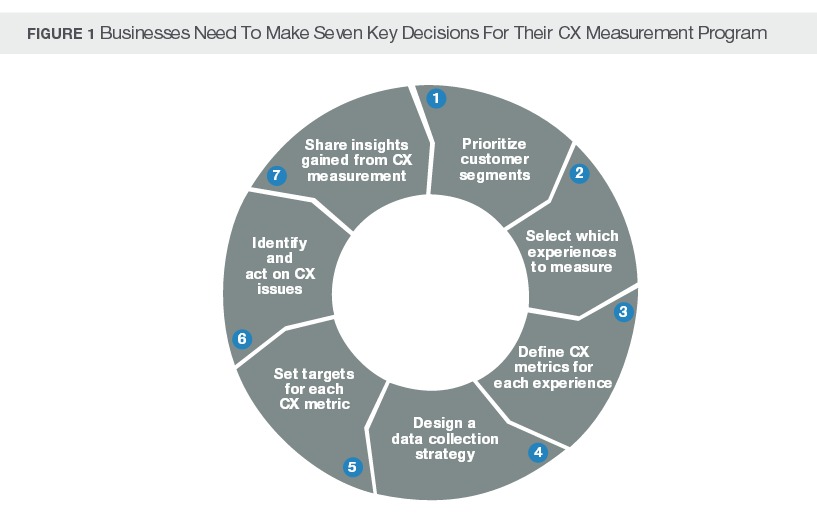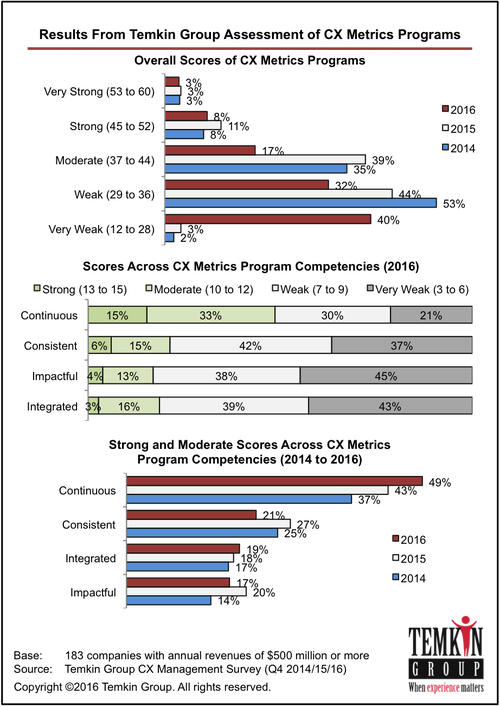 On the surface, customer experience (CX) seems like an intangible concept. Even industry experts agree that emotions are the heart of experiences. Still, experts concur that establishing a CX metrics program is vitally essential for lasting success.
On the surface, customer experience (CX) seems like an intangible concept. Even industry experts agree that emotions are the heart of experiences. Still, experts concur that establishing a CX metrics program is vitally essential for lasting success.
A solid CX measurement framework lets your company know how well you are performing with your customers. However, there are several dimensions of customer experience, each with their own measurement parameters:
- Customer Transactions– A specific exchange between a customer and frontline representative—such as a call to a contact center or home visit by a field service technician. Typically, companies seek feedback on interactions shortly after they take place.
- Customer Journeys – A series of experiences that add up to a single larger outcome, such as taking a flight or making a major purchase. Organizations often seek feedback soon after the culmination of a journey experience.
- Customer Relationships – A customer’s overall experience with a brand, which can include multiple, distinct interactions or journeys. Companies may seek periodic relationship feedback from customers—typically no more than two to four times per year.
As a result of the multi-faceted nature of the customer experience, creating a CX metrics program can be a challenge. With awareness of common pitfalls companies face and a disciplined approach, you can create the right metrics framework for you company.
Two Ways CX Metrics Programs Often Falter
Creating a survey program is a usual first step for any company that has embarked on CX initiatives. Surveys provide valuable feedback from customers about their experiences—so it would seem like these companies have made progress. They have – but if their CX measurement programs lack consistency or don’t drive action—they may find their CX efforts stagnating.
1. Lack of Consistency
In the early days of a CX program, companies may have an inconsistent approach to feedback gathering.
They may use different surveys—with different questions—across various customer-facing units. And those departments may keep results to themselves instead of communicating them with leaders or peers. Also, companies in this stage often haven’t settled on company-wide CX metrics that highlight a consistent view of customer experiences across different segments of the frontline operation.
This siloed approach prevents companies from gaining actionable, company-wide insight about customer perceptions.
2. Lack of Action
Over time, companies typically evolve to a more streamlined CX metrics practice. They do a better job of collecting consistent metrics across the service footprint, perform analytics, and use reporting and dashboards to keep leaders informed. In addition, they may be successful at sharing feedback with team members to ensure that the customer experience stays top-of-mind.
Despite this success in feedback gathering and analysis, they may still struggle with selecting key performance indicators (KPIs) that tie CX feedback to concrete actions to improve customer experiences. Often, organizations facing these problems may not have secured the full leadership buy-in and funding support they need to advance their CX program performance.
To overcome these hurdles, organizations can adopt a more disciplined approach to their CX metrics program.
Seven Essential Questions to Answer for CX Metrics Success
After dubbing the current business environment “The Age of the Customer,” analyst firm Forrester has put great emphasis on evaluating organizations’ CX practices. They’ve found that more than 80% of companies aspire to be a CX leader, but less than 20% have best-in-class CX programs.
Another key Forrester finding: CX measurement programs are lagging. Thirty-nine (39%) of surveyed companies don’t regularly seek feedback from customers—and 72% don’t tie CX data to business outcomes.
To help firms elevate their programs, Forrester created a seven-step model for CX metrics success:

Image Source: Forrester
Following this approach, companies need to ask—and answer—seven core questions as they progress their CX measurement programs:
- Which customer segments are we going to analyze? When designing or re-engineering a measurement program, companies may need to target high-priority customer segments. These can include those with high profitability or growth potential.
- Which experiences do we want to measure? A comprehensive measurement program will measure interactions, journeys, and relationships. However, Forrester advises companies should focus on measuring interactions and journeys first for the most tangible insight.
- What CX metrics will we use to evaluate each type of experience? Companies will need to select metrics that evaluate the quality of each experience, along with metrics that can influence critical business decisions.
- How are we going to collect feedback? After defining the purpose and focus of their feedback gathering efforts, companies need to focus on the mechanics of collecting customer insight. They need to select communications channels, design surveys, and optimize survey timing to maximize response rates.
- What is our current baseline—and goal—for each experience category? Companies need to understand their current level of performance—and then set achievable goals for where they want to be.
- What issues are we identifying through CX feedback-and how can we fix them? To make CX gains, companies need processes that identify customer-specific concerns and systemic issues. They need closed-loop alerting practices that charge managers with responsibility for resolving issues raised by unhappy customers, along with action planning to address any longer-term negative trends.
- How can we share CX feedback throughout our organization? Best-in-class companies share customer feedback regularly—and broadly. They communicate to CX stakeholders and frontline teams to keep the entire organization focused on customers.
Answering these seven questions can help companies design a successful CX measurement program and avoid common pitfalls.
Why a Disciplined CX Metrics Program Matters
Although most CX programs collect customer insight through surveys, turning this feedback into meaningful metrics and action doesn’t always occur. In fact, research from CX think tank Temkin Group revealed that just 11% of surveyed companies received a “very strong” or “strong” ratings for their CX measurement programs.

Image Source: Temkin Group
Another important finding from the Temkin research: only 10% of companies use metrics when making day-to-day business decisions. Yet, those with stronger CX metrics programs deliver higher-quality customer experiences.
Understanding how measurement programs falter—and how to adopt a disciplined approach—can help companies accelerate their CX initiatives. By building consistency into CX feedback gathering across the company and empowering support groups to take action, companies can move their CX metrics programs forward. They can make CX metrics more visible throughout the organization, align key decisions with customer feedback, and ultimately strengthen customer relationships.
Author: Connie Harrington
Connie is a content strategist and serves as managing editor of the eTouchPoint blog. Possessing 15+ years of international experience across five continents, her focus areas include: customer experience management, customer contact management, communications planning, content marketing, email marketing, and employee engagement. Previously, she held marketing and communications leadership positions at CGI, Mindwrap, and TEOCO. She earned a B.A., cum laude, from the College of William and Mary in Virginia.

